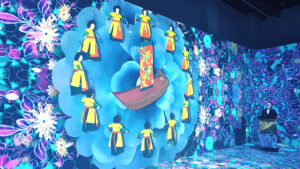IN THE CALM environs of the Korean Cultural Center of the Philippines (KCC), a spacious multipurpose hall at the fifth level has been transformed into an expansive panorama of immersive audio-visual projections.
The National Museum of Korea is responsible for bringing this mesmerizing — and free! — experience to the Philippines. Using new digital technology, they animated reinterpretations of traditional Korean art from the Joseon Dynasty (which flourished from the 1300s and lasted 500 more years until the establishment of the Korean Empire in 1897).
“Endless Landscape: Digitally Reimagined Korean Art” is made up of four videos: Endless Mountains and Rivers; Royal Processions with the People; Pillars of Divinity, Chongseok Rocks; and Peonies in Bloom.
“This special exhibition showcases Korea’s unique traditions, culture, and artistic works through digital technology, and we hope that many Filipinos will discover new connections with Korea through it,” KCC director Kim Myeongjin said at the exhibition’s launch on Jan. 18.
Upon entering the hall, visitors are enveloped in a rich tapestry of landscapes and historical scenes. The space is “an intersection of the cultural heritage of the past and the digital technology of the present,” according to Mr. Kim.
The first video played in the exhibit is Endless Mountains and Rivers, based on the 18th-century masterpiece by royal court painter Yi Inmun. It depicts people living in harmony with nature, a utopia sought by Koreans in the late Joseon Dynasty, brought to life with peaceful music and vibrant animations.
The second, entitled Royal Processions with the People, is a fascinating and colorful take on uigwe, or records of royal protocols. This particular piece depicts a court procession to the Hwaseong Fortress headed by King Jeongjo, a Joseon king who may be familiar to those who watch historical K-dramas.
Next up is Pillars of Divinity, Chongseok Rocks, a relaxing view of the Chongseok Rocks in Tongcheon, Gangwondo Province. The renowned attraction in the Geumgangsan Mountains was first painted by Kim Gyujin, for a commissioned work that once decorated Changdeokgung Palace. Now, the unusual, jagged rock forms dance beautifully in the digital exhibit.
Finally, the joyful animation Peonies in Bloom is based on a diptych showing peonies, part of the National Museum of Korea collection. The piece was originally installed in a palace building during the Joseon Dynasty. According to the exhibit’s notes, for Koreans, peonies are the “king of flowers” due to their splendid and elegant appearance, which is why they are a motif for royal rites and architecture.
Mr. Kim noted that aside from being visually impressive, these four videos are meant to help Filipinos “engage with Korean culture.”
For Lee Sang-hwa, the Ambassador of the Republic of Korea to the Philippines, the exhibit is a testament to the friendship between the two countries, celebrating the 75th anniversary of their diplomatic relations this year.
He told BusinessWorld that it is the first of many commemorative events lined up for 2024.
“We aim to ignite interest and appreciation among our Filipino friends. In recent years, the allure of Korean culture has extended beyond borders, primarily propelled by Hallyu, or the Korean wave,” Mr. Lee said.
KCC’s Mr. Kim added that the center has strived since 2011 to “introduce the rich tapestry of Korean culture to the Philippine mainstream.”
“Endless Landscape: Digitally Reimagined Korean Art” runs until June 29, at the fifth level of the Korean Cultural Center of the Philippines in Bayani Road, Taguig City. The exhibit is free of charge and is open to the public. — Brontë H. Lacsamana
